Gender Diversity and ESG's Impact on UK Firms' Financial Performance
VerifiedAdded on 2023/06/10
|58
|15922
|205
Report
AI Summary
This report investigates the relationship between ESG (Environmental, Social, and Governance) scores, gender diversity, and financial performance in UK firms, specifically focusing on FTSE 100 companies. It examines the research background, objectives, and literature gap, highlighting the growing importance of ESG reporting and gender diversity in the business world. The study explores whether gender diversity mediates the influence of ESG scores on financial outcomes. The report includes a literature review of existing research on ESG scores, gender diversity, and firm performance. It details the data sources, methodology, and model specifications used in the analysis, followed by an estimation model and analysis of results, comparing findings with previous studies. The report concludes with a discussion of the study's limitations and suggestions for future research, providing valuable insights into the interplay between ESG factors, gender diversity, and financial success in the UK context.
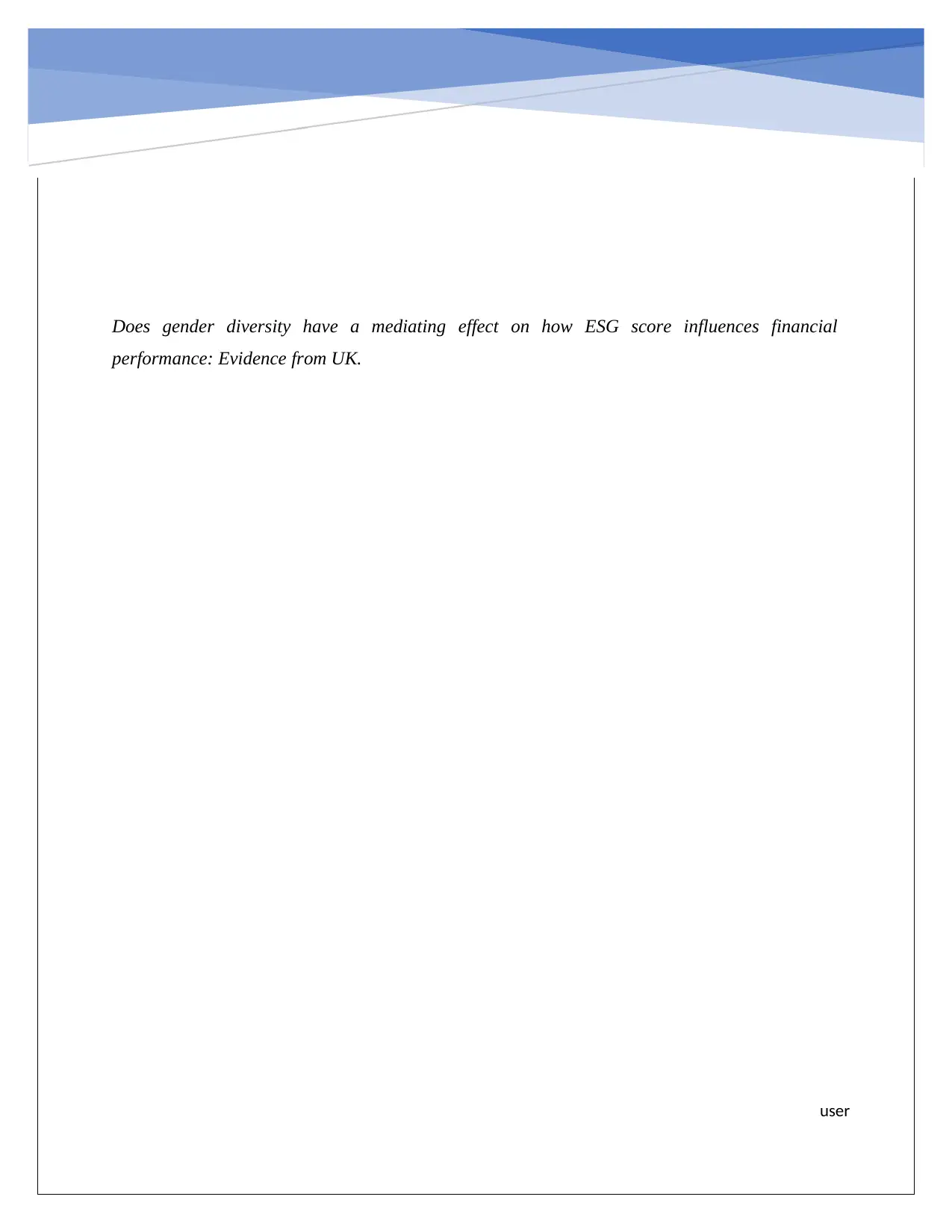
Does gender diversity have a mediating effect on how ESG score influences financial
performance: Evidence from UK.
user
performance: Evidence from UK.
user
Paraphrase This Document
Need a fresh take? Get an instant paraphrase of this document with our AI Paraphraser
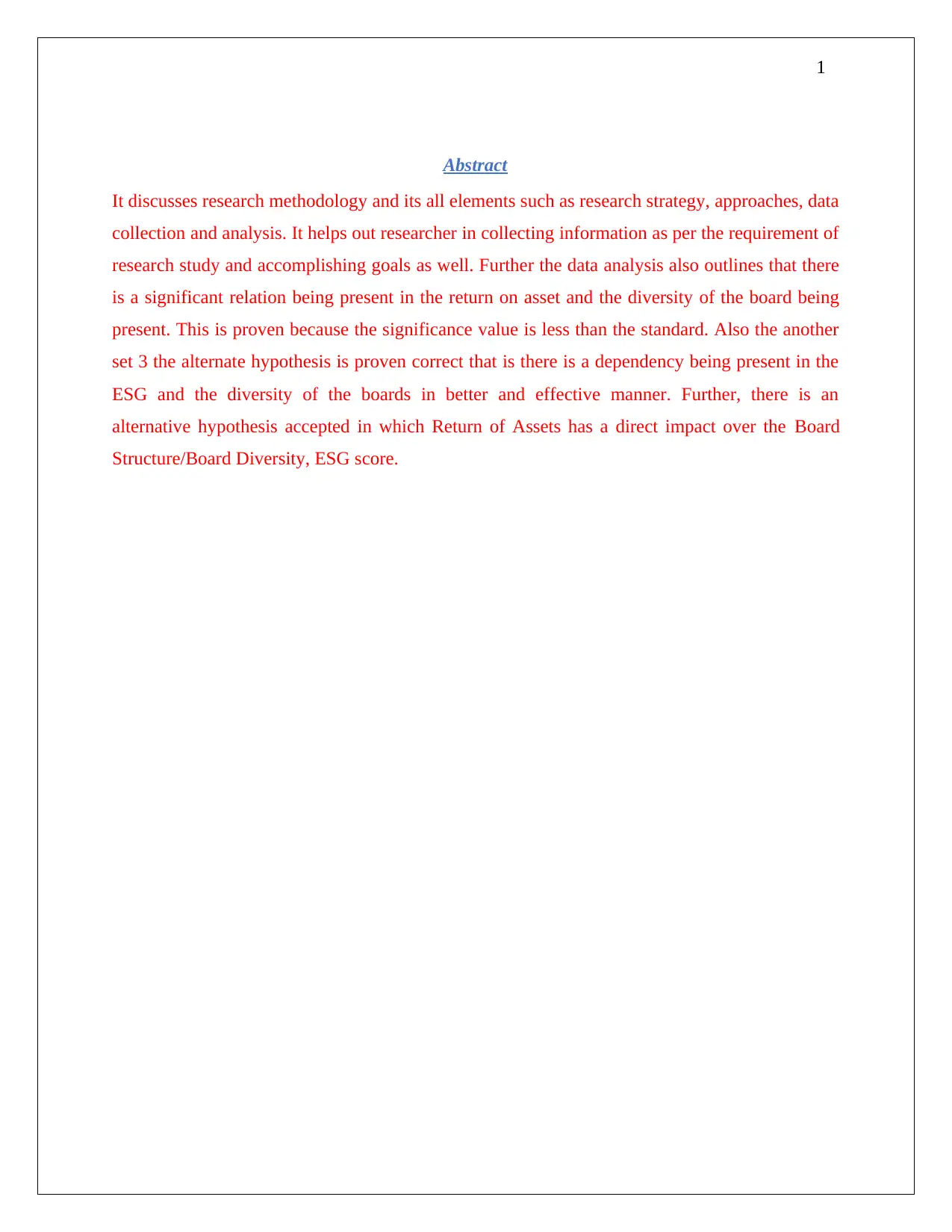
1
Abstract
It discusses research methodology and its all elements such as research strategy, approaches, data
collection and analysis. It helps out researcher in collecting information as per the requirement of
research study and accomplishing goals as well. Further the data analysis also outlines that there
is a significant relation being present in the return on asset and the diversity of the board being
present. This is proven because the significance value is less than the standard. Also the another
set 3 the alternate hypothesis is proven correct that is there is a dependency being present in the
ESG and the diversity of the boards in better and effective manner. Further, there is an
alternative hypothesis accepted in which Return of Assets has a direct impact over the Board
Structure/Board Diversity, ESG score.
Abstract
It discusses research methodology and its all elements such as research strategy, approaches, data
collection and analysis. It helps out researcher in collecting information as per the requirement of
research study and accomplishing goals as well. Further the data analysis also outlines that there
is a significant relation being present in the return on asset and the diversity of the board being
present. This is proven because the significance value is less than the standard. Also the another
set 3 the alternate hypothesis is proven correct that is there is a dependency being present in the
ESG and the diversity of the boards in better and effective manner. Further, there is an
alternative hypothesis accepted in which Return of Assets has a direct impact over the Board
Structure/Board Diversity, ESG score.

2
Acknowledgement
Acknowledgement
⊘ This is a preview!⊘
Do you want full access?
Subscribe today to unlock all pages.

Trusted by 1+ million students worldwide

3
Table of Contents
Abstract……………………………………………………………………………………………1
Acknowledgement………………………………………………………………………………...2
Chapter One….……………………………………………………………………………………3
Chapter 1.........................................................................................................................................5
1.1 Introduction:.........................................................................................................................5
1.2 Research background:............................................................................................................6
1.4 Literature Gap........................................................................................................................7
Chapter 2.......................................................................................................................................10
2. Literature Review......................................................................................................................10
2.1 Overview of ESG Score.......................................................................................................10
2.2 Influence of ESG Score on Financial Performance.............................................................12
2.3 Impact of Gender Diversity on ESG Score and Financial Performance.............................14
2.4 Influence of Gender Diversity on ESG Score in the UK.....................................................15
2.5 Influence of Gender Diversity on Financial Performance in the UK..................................16
2.6 Theoretical Framework........................................................................................................18
Chapter 3.......................................................................................................................................20
3.0 Data and Methodology............................................................................................................21
Table of Contents
Abstract……………………………………………………………………………………………1
Acknowledgement………………………………………………………………………………...2
Chapter One….……………………………………………………………………………………3
Chapter 1.........................................................................................................................................5
1.1 Introduction:.........................................................................................................................5
1.2 Research background:............................................................................................................6
1.4 Literature Gap........................................................................................................................7
Chapter 2.......................................................................................................................................10
2. Literature Review......................................................................................................................10
2.1 Overview of ESG Score.......................................................................................................10
2.2 Influence of ESG Score on Financial Performance.............................................................12
2.3 Impact of Gender Diversity on ESG Score and Financial Performance.............................14
2.4 Influence of Gender Diversity on ESG Score in the UK.....................................................15
2.5 Influence of Gender Diversity on Financial Performance in the UK..................................16
2.6 Theoretical Framework........................................................................................................18
Chapter 3.......................................................................................................................................20
3.0 Data and Methodology............................................................................................................21
Paraphrase This Document
Need a fresh take? Get an instant paraphrase of this document with our AI Paraphraser

4
3.1 Data Sources:.......................................................................................................................21
3.3 Model specification:............................................................................................................25
...................................................................................................................................................26
Chapter 4.......................................................................................................................................26
4.0 Portfolio formation, model estimation and analysis............................................................27
4.1 Regression model, estimation and analysis of results:........................................................27
Chapter 5.......................................................................................................................................42
6.0 References...............................................................................................................................45
3.1 Data Sources:.......................................................................................................................21
3.3 Model specification:............................................................................................................25
...................................................................................................................................................26
Chapter 4.......................................................................................................................................26
4.0 Portfolio formation, model estimation and analysis............................................................27
4.1 Regression model, estimation and analysis of results:........................................................27
Chapter 5.......................................................................................................................................42
6.0 References...............................................................................................................................45

5
Chapter 1
Introduction
Chapter 1
Introduction
⊘ This is a preview!⊘
Do you want full access?
Subscribe today to unlock all pages.

Trusted by 1+ million students worldwide
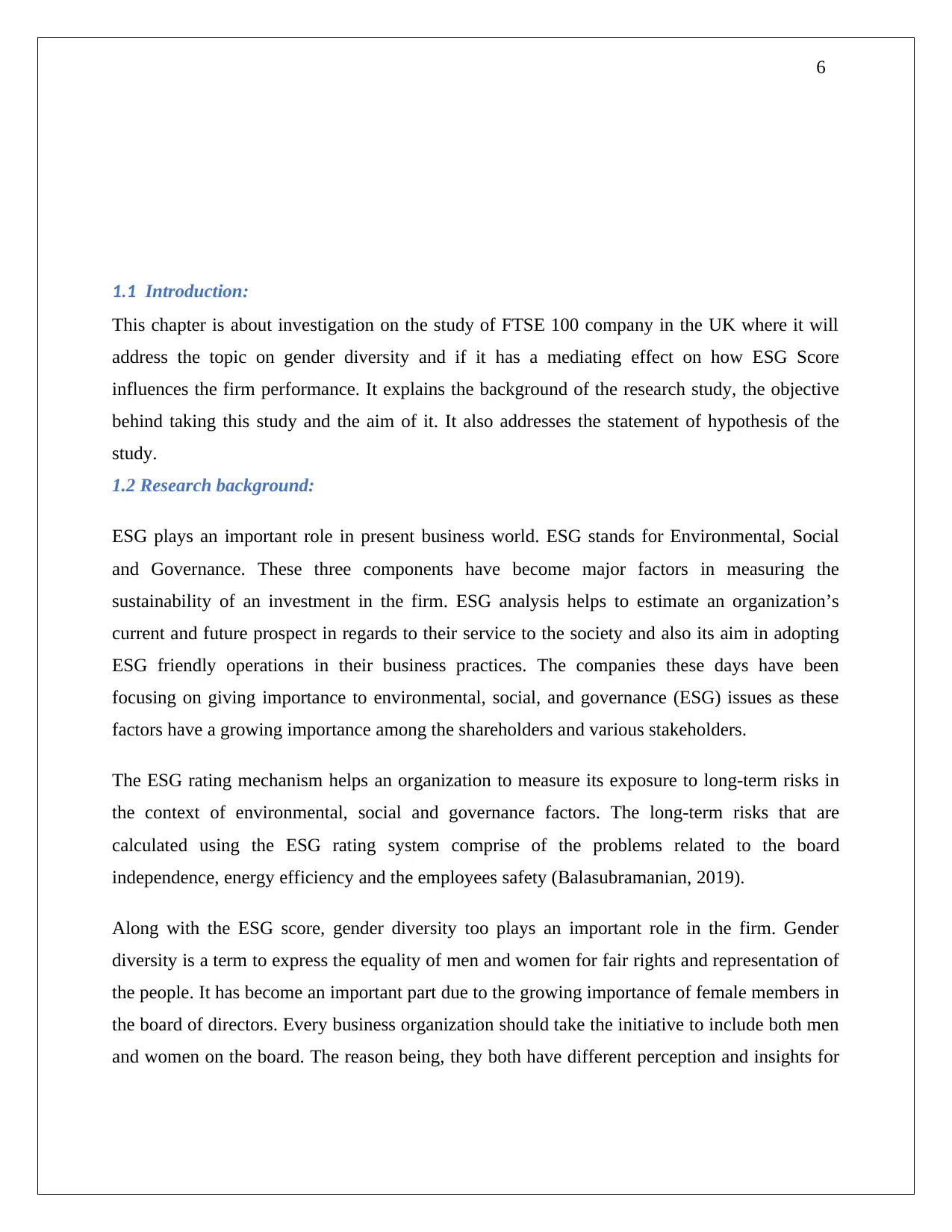
6
1.1 Introduction:
This chapter is about investigation on the study of FTSE 100 company in the UK where it will
address the topic on gender diversity and if it has a mediating effect on how ESG Score
influences the firm performance. It explains the background of the research study, the objective
behind taking this study and the aim of it. It also addresses the statement of hypothesis of the
study.
1.2 Research background:
ESG plays an important role in present business world. ESG stands for Environmental, Social
and Governance. These three components have become major factors in measuring the
sustainability of an investment in the firm. ESG analysis helps to estimate an organization’s
current and future prospect in regards to their service to the society and also its aim in adopting
ESG friendly operations in their business practices. The companies these days have been
focusing on giving importance to environmental, social, and governance (ESG) issues as these
factors have a growing importance among the shareholders and various stakeholders.
The ESG rating mechanism helps an organization to measure its exposure to long-term risks in
the context of environmental, social and governance factors. The long-term risks that are
calculated using the ESG rating system comprise of the problems related to the board
independence, energy efficiency and the employees safety (Balasubramanian, 2019).
Along with the ESG score, gender diversity too plays an important role in the firm. Gender
diversity is a term to express the equality of men and women for fair rights and representation of
the people. It has become an important part due to the growing importance of female members in
the board of directors. Every business organization should take the initiative to include both men
and women on the board. The reason being, they both have different perception and insights for
1.1 Introduction:
This chapter is about investigation on the study of FTSE 100 company in the UK where it will
address the topic on gender diversity and if it has a mediating effect on how ESG Score
influences the firm performance. It explains the background of the research study, the objective
behind taking this study and the aim of it. It also addresses the statement of hypothesis of the
study.
1.2 Research background:
ESG plays an important role in present business world. ESG stands for Environmental, Social
and Governance. These three components have become major factors in measuring the
sustainability of an investment in the firm. ESG analysis helps to estimate an organization’s
current and future prospect in regards to their service to the society and also its aim in adopting
ESG friendly operations in their business practices. The companies these days have been
focusing on giving importance to environmental, social, and governance (ESG) issues as these
factors have a growing importance among the shareholders and various stakeholders.
The ESG rating mechanism helps an organization to measure its exposure to long-term risks in
the context of environmental, social and governance factors. The long-term risks that are
calculated using the ESG rating system comprise of the problems related to the board
independence, energy efficiency and the employees safety (Balasubramanian, 2019).
Along with the ESG score, gender diversity too plays an important role in the firm. Gender
diversity is a term to express the equality of men and women for fair rights and representation of
the people. It has become an important part due to the growing importance of female members in
the board of directors. Every business organization should take the initiative to include both men
and women on the board. The reason being, they both have different perception and insights for
Paraphrase This Document
Need a fresh take? Get an instant paraphrase of this document with our AI Paraphraser
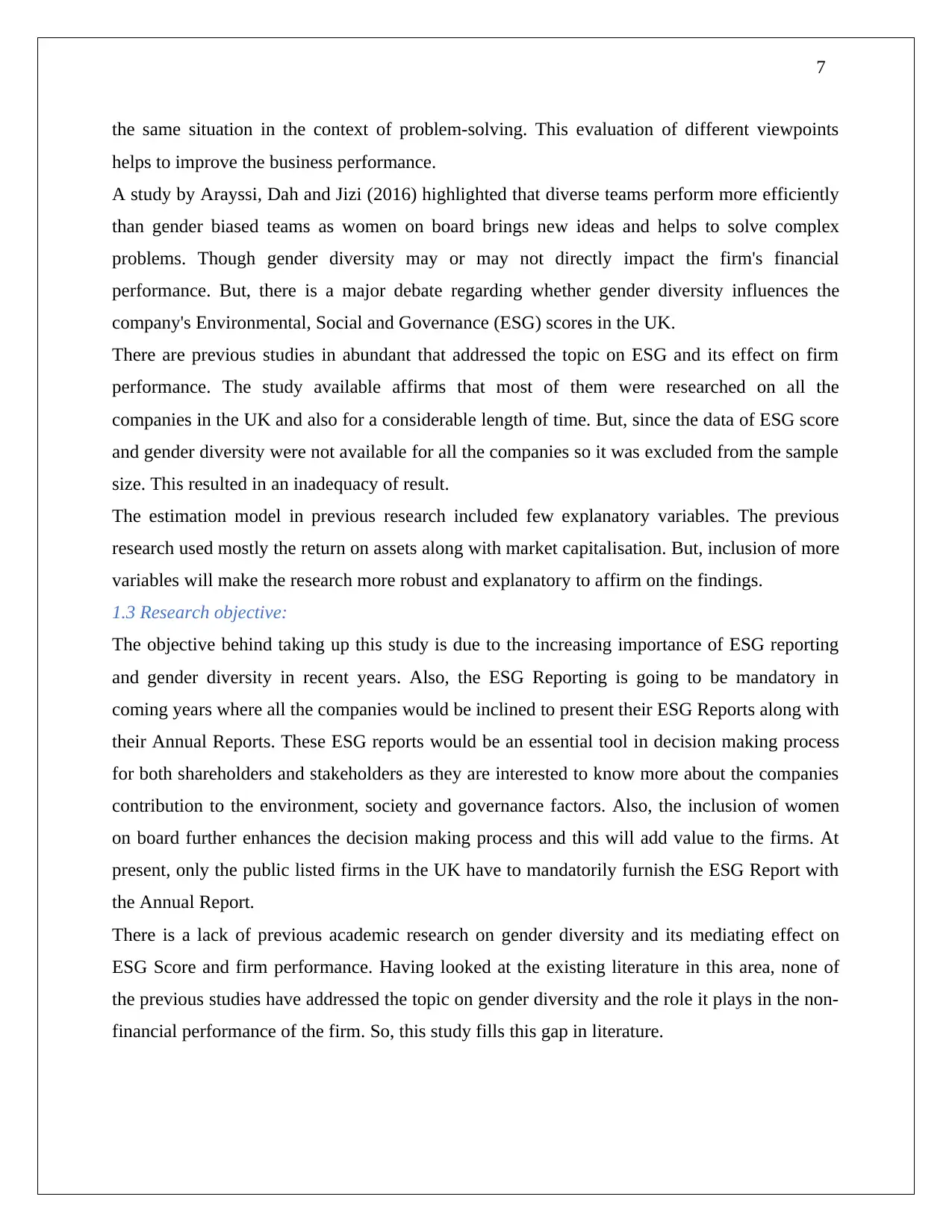
7
the same situation in the context of problem-solving. This evaluation of different viewpoints
helps to improve the business performance.
A study by Arayssi, Dah and Jizi (2016) highlighted that diverse teams perform more efficiently
than gender biased teams as women on board brings new ideas and helps to solve complex
problems. Though gender diversity may or may not directly impact the firm's financial
performance. But, there is a major debate regarding whether gender diversity influences the
company's Environmental, Social and Governance (ESG) scores in the UK.
There are previous studies in abundant that addressed the topic on ESG and its effect on firm
performance. The study available affirms that most of them were researched on all the
companies in the UK and also for a considerable length of time. But, since the data of ESG score
and gender diversity were not available for all the companies so it was excluded from the sample
size. This resulted in an inadequacy of result.
The estimation model in previous research included few explanatory variables. The previous
research used mostly the return on assets along with market capitalisation. But, inclusion of more
variables will make the research more robust and explanatory to affirm on the findings.
1.3 Research objective:
The objective behind taking up this study is due to the increasing importance of ESG reporting
and gender diversity in recent years. Also, the ESG Reporting is going to be mandatory in
coming years where all the companies would be inclined to present their ESG Reports along with
their Annual Reports. These ESG reports would be an essential tool in decision making process
for both shareholders and stakeholders as they are interested to know more about the companies
contribution to the environment, society and governance factors. Also, the inclusion of women
on board further enhances the decision making process and this will add value to the firms. At
present, only the public listed firms in the UK have to mandatorily furnish the ESG Report with
the Annual Report.
There is a lack of previous academic research on gender diversity and its mediating effect on
ESG Score and firm performance. Having looked at the existing literature in this area, none of
the previous studies have addressed the topic on gender diversity and the role it plays in the non-
financial performance of the firm. So, this study fills this gap in literature.
the same situation in the context of problem-solving. This evaluation of different viewpoints
helps to improve the business performance.
A study by Arayssi, Dah and Jizi (2016) highlighted that diverse teams perform more efficiently
than gender biased teams as women on board brings new ideas and helps to solve complex
problems. Though gender diversity may or may not directly impact the firm's financial
performance. But, there is a major debate regarding whether gender diversity influences the
company's Environmental, Social and Governance (ESG) scores in the UK.
There are previous studies in abundant that addressed the topic on ESG and its effect on firm
performance. The study available affirms that most of them were researched on all the
companies in the UK and also for a considerable length of time. But, since the data of ESG score
and gender diversity were not available for all the companies so it was excluded from the sample
size. This resulted in an inadequacy of result.
The estimation model in previous research included few explanatory variables. The previous
research used mostly the return on assets along with market capitalisation. But, inclusion of more
variables will make the research more robust and explanatory to affirm on the findings.
1.3 Research objective:
The objective behind taking up this study is due to the increasing importance of ESG reporting
and gender diversity in recent years. Also, the ESG Reporting is going to be mandatory in
coming years where all the companies would be inclined to present their ESG Reports along with
their Annual Reports. These ESG reports would be an essential tool in decision making process
for both shareholders and stakeholders as they are interested to know more about the companies
contribution to the environment, society and governance factors. Also, the inclusion of women
on board further enhances the decision making process and this will add value to the firms. At
present, only the public listed firms in the UK have to mandatorily furnish the ESG Report with
the Annual Report.
There is a lack of previous academic research on gender diversity and its mediating effect on
ESG Score and firm performance. Having looked at the existing literature in this area, none of
the previous studies have addressed the topic on gender diversity and the role it plays in the non-
financial performance of the firm. So, this study fills this gap in literature.
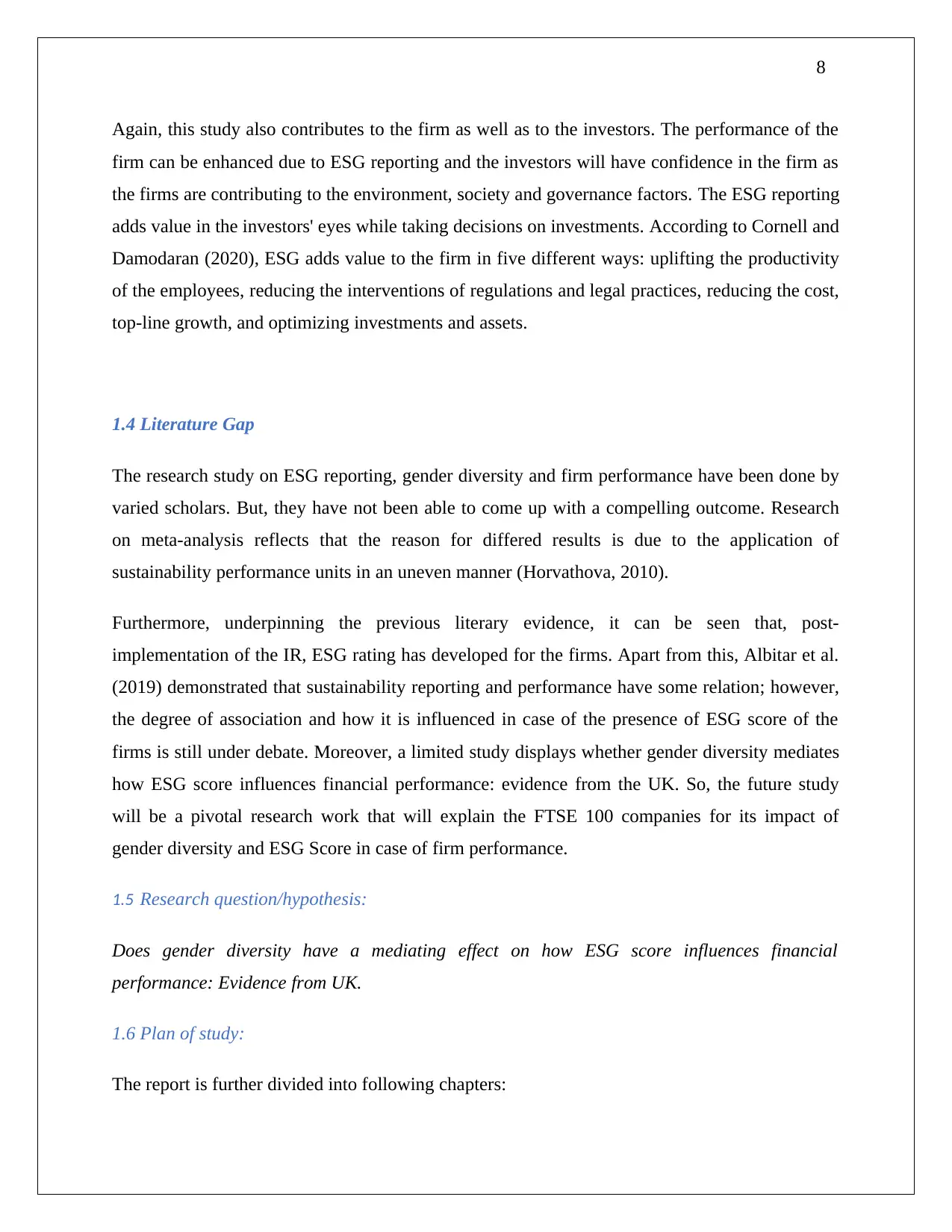
8
Again, this study also contributes to the firm as well as to the investors. The performance of the
firm can be enhanced due to ESG reporting and the investors will have confidence in the firm as
the firms are contributing to the environment, society and governance factors. The ESG reporting
adds value in the investors' eyes while taking decisions on investments. According to Cornell and
Damodaran (2020), ESG adds value to the firm in five different ways: uplifting the productivity
of the employees, reducing the interventions of regulations and legal practices, reducing the cost,
top-line growth, and optimizing investments and assets.
1.4 Literature Gap
The research study on ESG reporting, gender diversity and firm performance have been done by
varied scholars. But, they have not been able to come up with a compelling outcome. Research
on meta-analysis reflects that the reason for differed results is due to the application of
sustainability performance units in an uneven manner (Horvathova, 2010).
Furthermore, underpinning the previous literary evidence, it can be seen that, post-
implementation of the IR, ESG rating has developed for the firms. Apart from this, Albitar et al.
(2019) demonstrated that sustainability reporting and performance have some relation; however,
the degree of association and how it is influenced in case of the presence of ESG score of the
firms is still under debate. Moreover, a limited study displays whether gender diversity mediates
how ESG score influences financial performance: evidence from the UK. So, the future study
will be a pivotal research work that will explain the FTSE 100 companies for its impact of
gender diversity and ESG Score in case of firm performance.
1.5 Research question/hypothesis:
Does gender diversity have a mediating effect on how ESG score influences financial
performance: Evidence from UK.
1.6 Plan of study:
The report is further divided into following chapters:
Again, this study also contributes to the firm as well as to the investors. The performance of the
firm can be enhanced due to ESG reporting and the investors will have confidence in the firm as
the firms are contributing to the environment, society and governance factors. The ESG reporting
adds value in the investors' eyes while taking decisions on investments. According to Cornell and
Damodaran (2020), ESG adds value to the firm in five different ways: uplifting the productivity
of the employees, reducing the interventions of regulations and legal practices, reducing the cost,
top-line growth, and optimizing investments and assets.
1.4 Literature Gap
The research study on ESG reporting, gender diversity and firm performance have been done by
varied scholars. But, they have not been able to come up with a compelling outcome. Research
on meta-analysis reflects that the reason for differed results is due to the application of
sustainability performance units in an uneven manner (Horvathova, 2010).
Furthermore, underpinning the previous literary evidence, it can be seen that, post-
implementation of the IR, ESG rating has developed for the firms. Apart from this, Albitar et al.
(2019) demonstrated that sustainability reporting and performance have some relation; however,
the degree of association and how it is influenced in case of the presence of ESG score of the
firms is still under debate. Moreover, a limited study displays whether gender diversity mediates
how ESG score influences financial performance: evidence from the UK. So, the future study
will be a pivotal research work that will explain the FTSE 100 companies for its impact of
gender diversity and ESG Score in case of firm performance.
1.5 Research question/hypothesis:
Does gender diversity have a mediating effect on how ESG score influences financial
performance: Evidence from UK.
1.6 Plan of study:
The report is further divided into following chapters:
⊘ This is a preview!⊘
Do you want full access?
Subscribe today to unlock all pages.

Trusted by 1+ million students worldwide

9
Chapter Two: Literature Review
This chapter discusses the work of previous scholars and sheds light on previous empirical
studies on the ESG scores and the influence of the ESG score on the financial performance of
different organizations. It also highlights previous studies on gender diversity and its effect on
ESG scores and financial performance. Furthermore, the chapter discusses the objective behind
the research of previous scholars, methodology undertaken, estimation model used to derive the
results and the conclusion on their work. It also critically analyse the findings of scholars made
during their research study.
Chapter Three: Data and Methodology
This chapter discusses the data that has been used in the research and the techniques the research
has used to analyse the data and their outcome.
Chapter Four: Estimation model and analysis
This chapter highlights the estimation model that has been used to derive the result from the data
that has been discussed in chapter three and it analyses the outcome derived from regression. It
also discusses the results by comparing it to previous scholar works to highlight the differences
and similarities on the outcome.
Chapter Five: Conclusion
After performing the analysis, chapter five would present the conclusion on the basis of the result
that has been obtained in this study. This chapter also discusses the limitations of this research
work and the scope of future research.
Chapter Two: Literature Review
This chapter discusses the work of previous scholars and sheds light on previous empirical
studies on the ESG scores and the influence of the ESG score on the financial performance of
different organizations. It also highlights previous studies on gender diversity and its effect on
ESG scores and financial performance. Furthermore, the chapter discusses the objective behind
the research of previous scholars, methodology undertaken, estimation model used to derive the
results and the conclusion on their work. It also critically analyse the findings of scholars made
during their research study.
Chapter Three: Data and Methodology
This chapter discusses the data that has been used in the research and the techniques the research
has used to analyse the data and their outcome.
Chapter Four: Estimation model and analysis
This chapter highlights the estimation model that has been used to derive the result from the data
that has been discussed in chapter three and it analyses the outcome derived from regression. It
also discusses the results by comparing it to previous scholar works to highlight the differences
and similarities on the outcome.
Chapter Five: Conclusion
After performing the analysis, chapter five would present the conclusion on the basis of the result
that has been obtained in this study. This chapter also discusses the limitations of this research
work and the scope of future research.
Paraphrase This Document
Need a fresh take? Get an instant paraphrase of this document with our AI Paraphraser

10
Chapter 2
Literature Review
Chapter 2
Literature Review
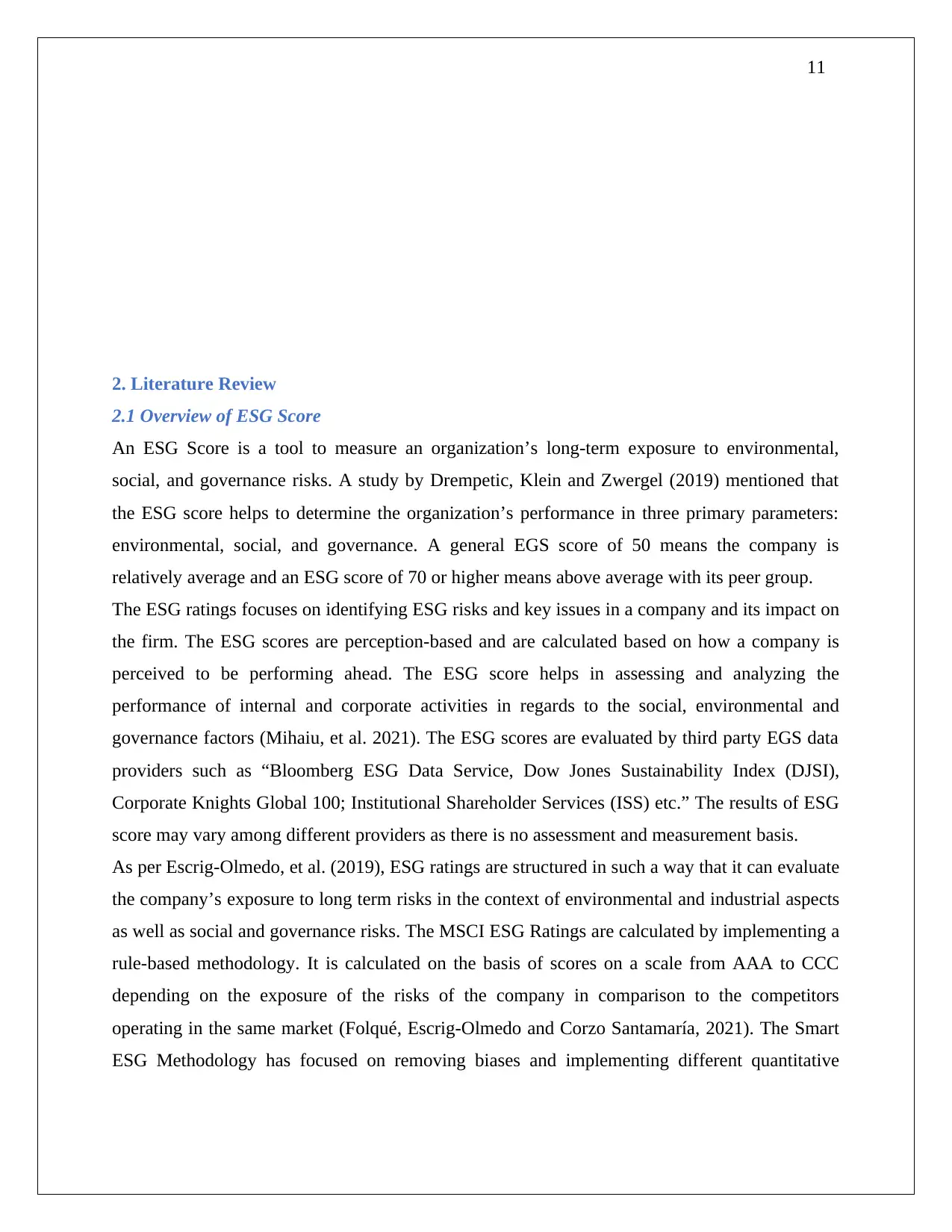
11
2. Literature Review
2.1 Overview of ESG Score
An ESG Score is a tool to measure an organization’s long-term exposure to environmental,
social, and governance risks. A study by Drempetic, Klein and Zwergel (2019) mentioned that
the ESG score helps to determine the organization’s performance in three primary parameters:
environmental, social, and governance. A general EGS score of 50 means the company is
relatively average and an ESG score of 70 or higher means above average with its peer group.
The ESG ratings focuses on identifying ESG risks and key issues in a company and its impact on
the firm. The ESG scores are perception-based and are calculated based on how a company is
perceived to be performing ahead. The ESG score helps in assessing and analyzing the
performance of internal and corporate activities in regards to the social, environmental and
governance factors (Mihaiu, et al. 2021). The ESG scores are evaluated by third party EGS data
providers such as “Bloomberg ESG Data Service, Dow Jones Sustainability Index (DJSI),
Corporate Knights Global 100; Institutional Shareholder Services (ISS) etc.” The results of ESG
score may vary among different providers as there is no assessment and measurement basis.
As per Escrig-Olmedo, et al. (2019), ESG ratings are structured in such a way that it can evaluate
the company’s exposure to long term risks in the context of environmental and industrial aspects
as well as social and governance risks. The MSCI ESG Ratings are calculated by implementing a
rule-based methodology. It is calculated on the basis of scores on a scale from AAA to CCC
depending on the exposure of the risks of the company in comparison to the competitors
operating in the same market (Folqué, Escrig‐Olmedo and Corzo Santamaría, 2021). The Smart
ESG Methodology has focused on removing biases and implementing different quantitative
2. Literature Review
2.1 Overview of ESG Score
An ESG Score is a tool to measure an organization’s long-term exposure to environmental,
social, and governance risks. A study by Drempetic, Klein and Zwergel (2019) mentioned that
the ESG score helps to determine the organization’s performance in three primary parameters:
environmental, social, and governance. A general EGS score of 50 means the company is
relatively average and an ESG score of 70 or higher means above average with its peer group.
The ESG ratings focuses on identifying ESG risks and key issues in a company and its impact on
the firm. The ESG scores are perception-based and are calculated based on how a company is
perceived to be performing ahead. The ESG score helps in assessing and analyzing the
performance of internal and corporate activities in regards to the social, environmental and
governance factors (Mihaiu, et al. 2021). The ESG scores are evaluated by third party EGS data
providers such as “Bloomberg ESG Data Service, Dow Jones Sustainability Index (DJSI),
Corporate Knights Global 100; Institutional Shareholder Services (ISS) etc.” The results of ESG
score may vary among different providers as there is no assessment and measurement basis.
As per Escrig-Olmedo, et al. (2019), ESG ratings are structured in such a way that it can evaluate
the company’s exposure to long term risks in the context of environmental and industrial aspects
as well as social and governance risks. The MSCI ESG Ratings are calculated by implementing a
rule-based methodology. It is calculated on the basis of scores on a scale from AAA to CCC
depending on the exposure of the risks of the company in comparison to the competitors
operating in the same market (Folqué, Escrig‐Olmedo and Corzo Santamaría, 2021). The Smart
ESG Methodology has focused on removing biases and implementing different quantitative
⊘ This is a preview!⊘
Do you want full access?
Subscribe today to unlock all pages.

Trusted by 1+ million students worldwide
1 out of 58
Related Documents
Your All-in-One AI-Powered Toolkit for Academic Success.
+13062052269
info@desklib.com
Available 24*7 on WhatsApp / Email
![[object Object]](/_next/static/media/star-bottom.7253800d.svg)
Unlock your academic potential
Copyright © 2020–2025 A2Z Services. All Rights Reserved. Developed and managed by ZUCOL.





